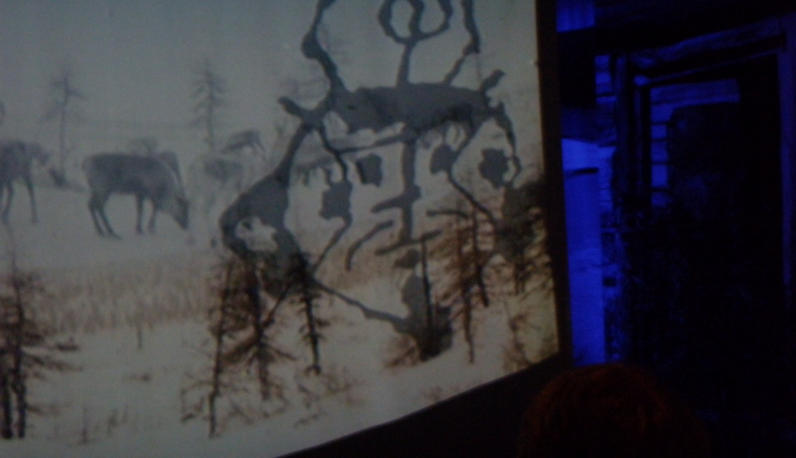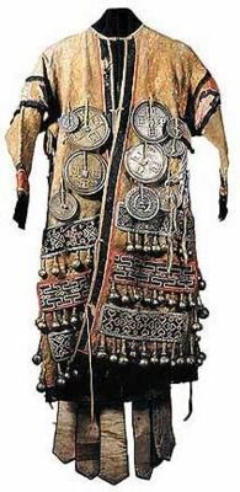
DongXi
There
are
three
different
types
of
shamans-
Black,
White,
and
Yellow.
The
first
two
of
these types are traditional and the third, a result of influence from
Buddhism
.
It
is
important
to
note
that
the
designations
of
“Black”
and
“White”
do
not
mean
“evil”
and
“good”.
There
are
different
types
of
spirits
that
shamans
work
with
and
they
reside
within
the
four
directions.
In
S
IBERIAN
TRADITION
,
each
direction
has
a
colour.
A
shaman’s colour is determined from which direction he gets his power.
Black Shaman Tradition
Black
shamans
are
the
most
powerful
of
all
the
shamans
and
they
get
their
power
from
the
Northern
direction.
They
are
warrior
shamans
and
overcome
evil
by
battling
might vs. might. They are the models of courage and discipline.
Historically,
Black
shamans
had
fulfilled
roles
in
both
times
of
peace
and
in
times
of
war.
In
wartime,
they
boosted
the
soldiers’
morale
and
did
cerimonies
to
help
in
battle.
The
power
of
the
army
was
connected
to
the
Black
shamans,
so
these
shamans
were
heavily recruited in times of war.
During
times
of
peace,
Black
shamans
served
as
advisors
and
conducted
foreign
policy
by
making
peace
and
alliances.
During
the
time
of
the
Mongolian
Empire
,
all
treaties were ratified by shaman ceremonies.
Both
historically
and
today,
Black
shamans
do
many
other
types
of
shamanic
work.
They
do
hunting
rituals,
healing
work,
protection,
divination,
and
curse
enemies.
Black
shamans
have
to
be
careful
to
stay
in
balance,
for
a
shaman
that
curses
too
much,
will lose their ability to heal and would become an outcast.
White Shaman Tradition
White
shamans
get
their
power
from
the
white
Western
direction.
Because
of
this,
they direct their prayers to the Western Heavens.
White
shamans
are
shamans
of
peace
and
have
a
special
relationship
with
the
spirits
of
nature.
Their
main
focus
is
on
pacifying
angry
spirits
and
helping
mankind
to
live
in
balance
with
nature.
White
shamans
also
do
divination
and
blessings.
One
thing
that
they can not do is a shaman’s curse.
During
the
Mongol
Empire,
while
Black
shamans
dealt
with
foreign
affairs,
White
shamans
dealt
with
local
affairs
and
served
as
administrators
and
concerned
themselves with the day to day lives of the people.
White
shamanism
in
present
time
has
Buddhist
inluence
in
it’s
trappings
and
style.
Some
chants
are
of
Buddhist
origin
and
White
shamans
burn
incense
instead
of
the
wild plants that Black shamans burn.
It
is
an
incorrect
stereotype
that
all
shamans
use
drums.
White
shamans
do
not
use
drums,
but
instead
have
a
wooden
staff
and
ring
bells
during
cerimonies.
White
shamans
also
do
not
wear
the
antlered
headdress
of
the
Black
shamans,
but
instead
wear a cape called a nemerge.
Lamaism
was
the
main
cause
of
the
decline
in
the
numbers
of
White
shamans.
During
the
17th
to
19th
centuries,
the
White
shaman
tradition
suffered
most
among
the
Khalkha
and
Barga
tribes,
and
throughout
Inner
Mongolia.
In
present
day,
white
shamanism is returning.
Yellow Shaman Tradition
Between
the
17th
and
19th
centuries,
Lamaism
(Tibetan
Buddhism)
imposed
itself
on
the
people
of
Mongolia.
During
this
time,
it
was
very
difficult
for
shamans.
Lamaists
divided
shamans
into
two
catagories:
Black
and
Yellow.
“Black”
shamans
were
those
who
kept
the
old
shamanic
traditions,
and
Yellow
shamans
were
those
who
would
submit
to
the Lamas and serve in a subordinate role to them.
Black
shamans
refused
to
submit
to
the
foreign
religion.
White
shamans
were
divided.
Some
submitted
to
Buddhist
authority
and
became
Yellow
shamans.
Other
White
shamans
refused
to
give
up
their
traditions.
These
shamans
were
thrown
into
the
“Black”
catagory
by
the
Lamaists.
Therefore,
both
Black
and
White
shamans
were
in
the
same
catagory
between the 17th and 19th centuries.
Because
of
this,
the
distinctions
between
the
two
traditions
was
muddied
in
Lamaist
dominated
regions.
Luckily,
the
tribes
in
the
Northwest
regions
such
as
the
Darhad
and
Urinahai
had
close
contact
and
solidarity
with
Siberian
peoples
such
as
the
Tuvans and Buryats who kept their traditions in tact.
Communism
in
Mongolia
stopped
the
Buddhist
attrocities,
but
was
a
step
backwards
for
freedom
of
religion.
When
Mongolia
changed
to
a
democracy
in
the
1990’s,
shamanism grew stronger in the region again.
“White
shamans”
have
returned
and
are
no
longer
forced
into
the
“Yellow”
catagory.
The “Yellow” catagory is no longer a shaman classification.


Schamanen | II




Schamane > Schamanen|Index > Shamantypes


Shamantypes
































